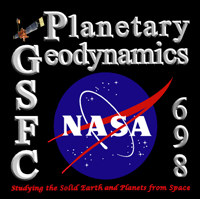

 |
Global studies of the lowlands on Mars have shown that the buried basement (below the smooth, relatively crater-free plains) is nearly as old as the highlands of Mars. But these studies only revealed the average age of the basement. Recently, Herb Frey and students Kristen Fristad, Gilbert DeSoto and Robin Lazrus have combined work over two years to address the question of whether different parts of the lowlands of Mars might have different ages (and, possibly, different processes of formation). Frey reported their results at the recent Geological Society of America meeting in Salt Lake City, Utah. |

|
|

|
Herb Frey is Chief of the Planetary Geodynamics Laboratory (Code 698). His main research focus is the early crustal evolution of the Moon, Mars and Earth. Every summer he works with students of all ages, providing them opportunities to do real research, most of which is later presented at meetings or published. |

|
Kirsten Fristad (far left) is a recent geology graduate of Macalester College in Minnesota. She was part of the NASA Academy program during the summer of 2005, and mapped and measured craters in the yellow areas above. Gilbert DeSoto (middle left) was a junior at Wright State University in Ohio when he studied craters in the green area above in 2004 as part of the Undergraduate Student Research Program. Robin Lazrus (near left) spent two summers (2004, 2005) as a National Space Club intern and mapped the areas shown in pink above. She is now a freshman at Carneige Mellon University. |
![]() Back to Planetary Geodynamics Science Highlights
Back to Planetary Geodynamics Science Highlights
Responsible NASA official: Dr. Herbert Frey